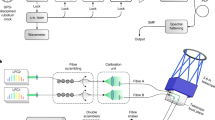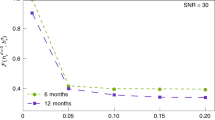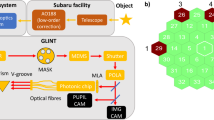Abstract
Orbiting planets induce a weak radial velocity (RV) shift in the host star that provides a powerful method of planet detection. Importantly, the RV technique provides information about the exoplanet mass, which is unavailable with the complementary technique of transit photometry. However, RV detection of an Earth-like planet in the ‘habitable zone’1 requires extreme spectroscopic precision that is only possible using a laser frequency comb (LFC)2. Conventional LFCs require complex filtering steps to be compatible with astronomical spectrographs, but a new chip-based microresonator device, the Kerr soliton microcomb3,4,5,6,7,8, is an ideal match for astronomical spectrograph resolution and can eliminate these filtering steps. Here, we demonstrate an atomic/molecular line-referenced soliton microcomb for calibration of astronomical spectrographs. These devices can ultimately provide LFC systems that would occupy only a few cubic centimetres9,10, thereby greatly expanding implementation of these technologies into remote and mobile environments beyond the research lab.
This is a preview of subscription content, access via your institution
Access options
Access Nature and 54 other Nature Portfolio journals
Get Nature+, our best-value online-access subscription
$29.99 / 30 days
cancel any time
Subscribe to this journal
Receive 12 print issues and online access
$209.00 per year
only $17.42 per issue
Buy this article
- Purchase on Springer Link
- Instant access to full article PDF
Prices may be subject to local taxes which are calculated during checkout




Similar content being viewed by others
Data availability
The data that support the plots within this paper and other findings of this study are available from the corresponding authors upon reasonable request.
References
Kasting, J. F., Whitmire, D. P. & Reynolds, R. T. Habitable zones around main sequence stars. Icarus 101, 108–128 (1993).
Diddams, S. A. The evolving optical frequency comb. J. Opt. Soc. Am. B 27, B51–B62 (2010).
Herr, T. et al. Temporal solitons in optical microresonators. Nat. Photon. 8, 145–152 (2014).
Yi, X., Yang, Q.-F., Yang, K. Y., Suh, M.-G. & Vahala, K. Soliton frequency comb at microwave rates in a high-Q silica microresonator. Optica 2, 1078–1085 (2015).
Brasch, V. et al. Photonic chip-based optical frequency comb using soliton Cherenkov radiation. Science 351, 357–360 (2016).
Wang, P.-H. et al. Intracavity characterization of micro-comb generation in the single-soliton regime. Opt. Express 24, 10890–10897 (2016).
Joshi, C. et al. Thermally controlled comb generation and soliton modelocking in microresonators. Opt. Lett. 41, 2565–2568 (2016).
Grudinin, I. S. et al. High-contrast Kerr frequency combs. Optica 4, 434–437 (2017).
Spencer, D. T. et al. An optical-frequency synthesizer using integrated photonics. Nature 557, 81–85 (2018).
Stern, B., Ji, X., Okawachi, Y., Gaeta, A. L. & Lipson, M. Battery-operated integrated frequency comb generator. Nature 562, 401–405 (2018).
Perryman, M. The Exoplanet Handbook (Cambridge University Press, Cambridge, UK, 2011).
Pepe, F., Ehrenreich, D. & Meyer, M. R. Instrumentation for the detection and characterization of exoplanets. Nature 513, 358–366 (2014).
Wilken, T. et al. A spectrograph for exoplanet observations calibrated at the centimetre-per-second level. Nature 485, 611–614 (2012).
Jones, D. J. et al. Carrier-envelope phase control of femtosecond mode-locked lasers and direct optical frequency synthesis. Science 288, 635–639 (2000).
Murphy, M. T. et al. High-precision wavelength calibration of astronomical spectrographs with laser frequency combs. Mon. Not. R. Astron. Soc. 380, 839–847 (2007).
Li, C.-H. et al. A laser frequency comb that enables radial velocity measurements with a precision of 1 cm s–1. Nature 452, 610–612 (2008).
Braje, D. A., Kirchner, M. S., Osterman, S., Fortier, T. & Diddams, S. Astronomical spectrograph calibration with broad-spectrum frequency combs. Euro. Phys. J. D 48, 57–66 (2008).
Steinmetz, T. et al. Laser frequency combs for astronomical observations. Science 321, 1335–1337 (2008).
McCracken, R. A., Charsley, J. M. & Reid, D. T. A decade of astrocombs: Recent advances in frequency combs for astronomy. Opt. Express 25, 15058–15078 (2017).
Glenday, A. G. et al. Operation of a broadband visible-wavelength astro-comb with a high-resolution astrophysical spectrograph. Optica 2, 250–254 (2015).
Murata, H., Morimoto, A., Kobayashi, T. & Yamamoto, S. Optical pulse generation by electrooptic-modulation method and its application to integrated ultrashort pulse generators. IEEE J. Sel. Top. Quantum Electron. 6, 1325–1331 (2000).
Huang, C., Jiang, Z., Leaird, D. & Weiner, A. High-rate femtosecond pulse generation via line-by-line processing of phase-modulated CW laser frequency comb. Electron. Lett. 42, 1114–1115 (2006).
Yi, X. et al. Demonstration of a near-IR line-referenced electro-optical laser frequency comb for precision radial velocity measurements in astronomy. Nat. Commun. 7,10436 (2016).
Beha, K. et al. Electronic synthesis of light. Optica 4, 406–411 (2017).
Carlson, D. R. et al. Ultrafast electro-optic light with subcycle control. Science 361, 1358–1363 (2018).
Metcalf, A. J. et al. Infrared astronomical spectroscopy for radial velocity measurements with 10 cm/s precision. CLEO: Sci. Innovations JTh5A-1 (2018).
Del’Haye, P. et al. Optical frequency comb generation from a monolithic microresonator. Nature 450, 1214–1217 (2007).
Kippenberg, T. J., Holzwarth, R. & Diddams, S. Microresonator-based optical frequency combs. Science 332, 555–559 (2011).
Kippenberg, T., Spillane, S. & Vahala, K. Kerr-nonlinearity optical parametric oscillation in an ultrahigh-Q toroid microcavity. Phys. Rev. Lett. 93, 083904 (2004).
Wabnitz, S. Suppression of interactions in a phase-locked soliton optical memory. Opt. Lett. 18, 601–603 (1993).
Leo, F. et al. Temporal cavity solitons in one-dimensional Kerr media as bits in an all-optical buffer. Nat. Photon. 4, 471–476 (2010).
Suh, M.-G., Yang, Q.-F., Yang, K. Y., Yi, X. & Vahala, K. J. Microresonator soliton dual-comb spectroscopy. Science 354, 600–603 (2016).
Dutt, A. et al. On-chip dual-comb source for spectroscopy. Sci. Adv. 4, e1701858 (2018).
Pavlov, N. et al. Soliton dual frequency combs in crystalline microresonators. Opt. Lett. 42, 514–517 (2017).
Trocha, P. et al. Ultrafast optical ranging using microresonator soliton frequency combs. Science 359, 887–891 (2018).
Suh, M.-G. & Vahala, K. J. Soliton microcomb range measurement. Science 359, 884–887 (2018).
Marin-Palomo, P. et al. Microresonator-based solitons for massively parallel coherent optical communications. Nature 546, 274–279 (2017).
Feng, Y. K. et al. The California Planet Survey IV: A planet orbiting the giant star HD 145934 and updates to seven systems with long-period planets. Astrophys. J. 800, 22 (2015).
Mahadevan, S. et al. The habitable-zone planet finder: a stabilized fiber-fed NIR spectrograph for the Hobby–Eberly telescope. Ground-Based and Airborne Instrumentation for Astronomy IV 8446, 84461S (2012).
Kotani, T. et al. Infrared Doppler instrument (IRD) for the Subaru telescope to search for Earth-like planets around nearby M-dwarfs. Ground-Based and Airborne Instrumentation for Astronomy V 9147, 914714 (2014).
McLean, I. S. et al. Design and development of NIRSPEC: a near-infrared echelle spectrograph for the Keck II telescope. Infrared Astronomical Instrumentation 3354, 566–579 (1998).
Lee, H. et al. Chemically etched ultrahigh-Q wedge-resonator on a silicon chip. Nat. Photon. 6, 369–373 (2012).
Blake, C. H., Charbonneau, D. & White, R. J. The NIRSPEC ultracool dwarf radial velocity survey. Astrophys. J. 723, 684 (2010).
Crepp, J. R. et al. iLocater: a diffraction-limited Doppler spectrometer for the Large Binocular Telescope. Ground-Based and Airborne Instrumentation for Astronomy VI 9908, 990819 (2016).
Lamb, E. S. et al. Optical-frequency measurements with a Kerr microcomb and photonic-chip supercontinuum. Phys. Rev. Appl. 9, 024030 (2018).
Lee, S. H. et al. Towards visible soliton microcomb generation. Nat. Commun. 8, 1295 (2017).
Lezius, M. et al. Space-borne frequency comb metrology. Optica 3, 1381–1387 (2016).
Plavchan, P. et al. EarthFinder: A precise radial velocity probe mission concept for the detection of Earth-mass planets orbiting Sun-like stars. Preprint at https://arXiv.org/abs/1803.03960 (2018).
Obrzud, E. et al. A microphotonic astrocomb. Nat. Photon. https://doi.org/10.1038/s41566-018-0309-y (2018).
Cai, M., Painter, O. & Vahala, K. J. Observation of critical coupling in a fiber taper to a silica-microsphere whispering-gallery mode system. Phys. Rev. Lett. 85, 74 (2000).
Spillane, S., Kippenberg, T., Painter, O. & Vahala, K. Ideality in a fiber-taper-coupled microresonator system for application to cavity quantum electrodynamics. Phys. Rev. Lett. 91, 043902 (2003).
Yi, X., Yang, Q.-F., Youl, K. & Vahala, K. Active capture and stabilization of temporal solitons in microresonators. Opt. Lett. 41, 2037–2040 (2016).
Cole, D., Beha, K., Diddams, S. & Papp, S. Octave-spanning supercontinuum generation via microwave frequency multiplication. J. Phys. Conf. Ser. 723, 012035 (2016).
Acknowledgements
We gratefully acknowledge J. Schlieder, A. Howard, F. Hadaegh and the support of the entire Keck summit team. We thank D. Carlson and H. Timmers for preparing the HNLF. The authors wish to recognize and acknowledge the very significant cultural role and reverence that the summit of Mauna Kea has always had within the indigenous Hawaiian community. The data presented herein were obtained at the W.M. Keck Observatory, which is operated as a scientific partnership among the California Institute of Technology, the University of California and NASA. The Observatory was made possible by the generous financial support of the W.M. Keck Foundation. This paper made use of data available in the NASA Exoplanet Archive and the Keck Observatory Archive. S.D. and S.P. acknowledge support from NIST. K.V., M.-G.S., X.Y. and Y.-H.L. thank the Kavli Nanoscience Institute and NASA for support under KJV.JPLNASA-1-JPL.1459106. This research was carried out at JPL and the California Institute of Technology under a contract with NASA and funded through the JPL Research and Technology Development Program.
Author information
Authors and Affiliations
Contributions
M.-G.S., S.L., G.V., M.P.F., D.M., S.B.P., S.A.D., C.B. and K.V. conceived the experiments. All co-authors designed and performed experiments. M.-G.S. and X.Y. built the soliton microcomb set-up and EO comb set-up with S.L., I.S.G., S.A.D., S.B.P. and Y.-H.L. providing assistance. G.D. managed operations and the experimental interface of the Keck II telescope. E.C.M., J.W. and C.B. analysed NIRSPEC data. C.B. and K.V. supervised the experiment. M.-G.S., C.B. and K.V. prepared the manuscript with input from all co-authors.
Corresponding authors
Ethics declarations
Competing interests
The authors declare no competing interests.
Additional information
Publisher’s note: Springer Nature remains neutral with regard to jurisdictional claims in published maps and institutional affiliations.
Rights and permissions
About this article
Cite this article
Suh, MG., Yi, X., Lai, YH. et al. Searching for exoplanets using a microresonator astrocomb. Nature Photon 13, 25–30 (2019). https://doi.org/10.1038/s41566-018-0312-3
Received:
Accepted:
Published:
Issue Date:
DOI: https://doi.org/10.1038/s41566-018-0312-3



